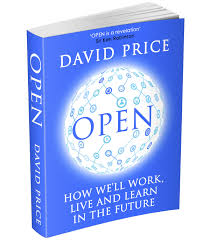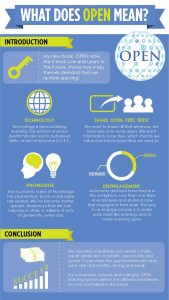 Published in 2013, I was surprised when my principal recommended this book to me – but I shouldn’t have been. His understandings of the world still apply, and though there is nascent progress in many areas, we are still in the early adoption of many of his findings. This book is about how taking an open stance in life and work and education will push humanity into true progress. He outlines a S.O.F.T. approach and provides examples of when organizations adopt an approach of:
Published in 2013, I was surprised when my principal recommended this book to me – but I shouldn’t have been. His understandings of the world still apply, and though there is nascent progress in many areas, we are still in the early adoption of many of his findings. This book is about how taking an open stance in life and work and education will push humanity into true progress. He outlines a S.O.F.T. approach and provides examples of when organizations adopt an approach of:
Share: being open to peer learning with colleagues and students
Open: physically changing the workspaces where we interact with colleagues and students to generate sharing and transmission of knowledge, skills and learning
Freedom: acknowledging that learning happens in different ways, spaces and at different times, and that informal learning counts!
Trust: Building an ethical core into education to support the shift of educators’ roles in schools
He finishes this treatise with practical advice for how to be OPEN and SOFT which is in a titled chapter: “The bit that would have saved you from having to read the whole book.” So you know that this book is written with wit and humour.
You would be interested in reading this book if you:
* Were looking for ways to understand how education is changing to a more open sharing disposition
* Wanted examples of education and businesses pivoting into a more open and sharing way of doing things, and finding success.
* Another researcher to align with in the work of shifting education
…Allow me to summarize, and suggest how, by going ‘open’, we might imagine things to be different (Price, 196)
This is what the entire book is about: imagining! He sets it up with his theory of S.O.F.T. and then follows this up with examples and ways to get there for our organizations, and for ourselves. This is both a personal and societal approach that he is advocating.
When I focus on the educational applications from his work, I start with his “Global Learning Commons” – a massive PLC, a mindset, and a way of working in education that requires educators to think differently about their practice:
[The Global Learning Commons] encompasses the ‘ecology’ of learning: the relationships we have with each other; the creation of an hospitable habitat for learning; how we cultivate the evolution of learning in communal, social environments, to transfer it successfully to others, establishing a set of commonly agreed principles which will make learning inclusive and innovative.(Price, 78)
His is a call to share our practices and be open to shifting it to something that is more relevant in order to avoid irrelevance. He cites numerous examples of the way societal change is outstripping education’s place in the world: companies, organizations, governments and people. Yet, education remains relatively static in this landscape. He does cite schools specifically, namely High Tech High. But in reading this, I wonder what David Price would make of the burgeoning market for smaller, niche schools that we are seeing?
We have to abandon the antiquated, enclosed learning systems upon which we currently rely, and seek to engage the young social activists, entrepreneurs and technologists of today in re-imagining the open systems of tomorrow. And fast. (Price, 101)
How might we go about doing this? Adopt a SOFT approach:
Looking at this chart above, it gives us clues as to how to move and learn differently in education to support how we can work in the future to better our chances. In order for education to not only maintain relevance, but to ADD VALUE to society, we need to adopt this approach. After citing several examples, he states:
But there’s another more compelling reason to change, and it’s this. These values and action – Share Open Free, Trust – are looked for and displayed every day that we interact socially…If we don’t see the values and actions that we display to each other elsewhere in [our world], we’ll simply take our business elsewhere…The old system of work-based learning was designed for the industrial age, but the ‘open revolution’ has not yet shaped the learning system we’ll need for future needs. There is, however, no point in waiting until it all settles down. (Price, 154)
He ends the book with a clever how-to section that I alluded to above. These speak to me as being more like mindsets – much like Design Thinking Mindsets:
- Engage in Engagement: make learning social, and make it social beyond the walls of the school. Don’t do learning for grades, make learning relevant to the lived experience of the students and adults in the building
- Value Values: shift from a culture of servitude, to a culture of service. How might your learning benefit others in the school and elsewhere?
- Trust in Trust: Trust and responsibility go hand-in-hand, so we need to build trusting relationships with the students and the adults
- Learn about Learning: promote learning at work, not just for compliance, but to grow the resilience in your employees, to model , and create “flow” of ideas and practices. Collaboration is the foundation of learning, failure is a great teacher, and creating learning moments are powerful builders of trust and innovation.
Many may wonder: “What role does technology play in this Open Future?” The answer is that technology is no longer a thing or a tool. Technology just is. There is no clear lines between technology and the self – and we see this even now. There once was a vibrant market for “EdTech”, but we see now that it is all just “Tech”. And there is a need for more digital wisdom to allow us to bring some clarity to the blurred lines of WHY and HOW of technology as it relates to our own identity, how we see and connect with others.
And so, when the author ends the book with a section dedicated to “You, the Reader”, it is important to reflect on how we can be Open in our own lives through technology. Use it to connect, use it to communicate and use it to learn. But what about our students – even our own children? Though published in 2013, I think that his stance on screen time applies as a way for us to reflect not on “HOW MUCH” screen time, but “WHAT TYPE” of interactions they are having on the screen:
Two of the wisest experts out there, Cathy Davidson and Sherry Turkle, recently published well-researched, yet sharply contrasting analysis of how technology affects young people’s desire and abilities to socially interact with each other. Ths goes to the heart of the current dilemma for parents…Since there’s no incontrovertible evidence that would guide us here, you may as well relax, they’ll find the answer themselves. (Price, 210)
I’ll end with this quotation, which I find inspiring in our time of school closures and isolation:
“This new concept of educational success focuses on the nurturing of key skills and competencies such as the ability to seek, to curate and to synthesize information; to create and innovate; to work in diverse cross-cultural teams; as as to appreciate global issues within the local context.” (Price, 166)
I thoroughly enjoyed this book, and will add it to the section in my library of “WHY” and “HOW” to continue to shift education. I hope that you do as well.

